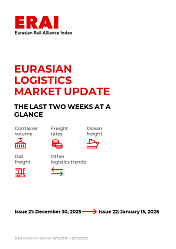«We also see that inventories are depleted in many cases and so far we’ve seen a good recovery after Chinese New Year,» Jansen said. «So we’ve been fairly happy with that.»
The company reported a steep drop in its 2023 net profit this week and slashed its dividend, which led to a stock decline. It was the third-best group profit in company history, albeit significantly lower than 2022, which was fueled by container congestion and high freight rates.
«The last quarter of 23 was difficult because rates were at unsustainable levels,» Jansen said. «I think everybody noticed that. We saw them coming up a bit towards the end of the quarter, and then of course, the Red Sea crisis ... which again changed the market.»
Added climate costs from Red Sea diversions
While the Red Sea issues have resulted in a shipping container rate spike, Hapag-Lloyd is forecasting a decrease in its earnings this year as costs increase related to the trade diversions from the Red Sea.
According to SONAR, the price of 40-foot containers started its run-up in the U.S. on Jan 3, ranging from $3,063-$3,763 to a peaked on Feb. 9 from $5,353-$7,329. While rates have now declined, U.S. companies are paying more, with rates from Asia to West Coast ports up 155% year-to-date; Asia to East Coast up 129% year-to-date; and Asia to the Gulf Coast up 71.2% year-to-date.
Where global shipping rates are headed in 2024 with Red Sea attacks continuing
Attacks by the Houthis on commercial shipping interests in the Red Sea continue, with a tanker attacked in the Red Sea Friday while underway northbound in the Red Sea, though the tanker was empty at the time and continued on its journey, with no crew injuries reported. The day prior, the tanker was assessed to have been the subject of a near miss 47 miles southeast of Aden, Yemen.
«It’s a concerning situation and I think the [Red Sea] outlook is very difficult,» Jansen said. «We hope that it will be over in a couple of months. But I’m very well aware that despite all the efforts that many countries are undertaking, some also believe that it might last quite a bit longer. In the end, we will do whatever we can to keep our people safe, even if that means that transit times are going to be a little bit longer.»
The route around the Horn of Africa is longer and more fuel is being burned by container vessels. In addition to the added costs, according to Sea-Intelligence, the Red Sea diversions could increase carbon dioxide emissions by 260%—354%.
As a result, ocean carriers with Europe-bound vessels will be paying higher emissions liabilities under the EU Emissions Trading System. According to maritime technology firm OceanScore’s calculations, with the diversions increasing fuel consumption and sailing speed from 16-20 knots to make up some time, the emissions trading system imposes a 50% liability for voyages either originating from the EU or traveling to it, and 100% liability for ships docked at an EU port or completing transits from one EU bloc port to another.
The longer voyages are creating a challenging and costly environment for Hapag Lloyd which has a goal of being net-zero carbon by 2045.
«That is definitely a big problem,» Hansen said. «Today we have to sail faster and we have to sail more. So that does not help us to achieve those sustainability goals. I would hope, however, that this is a temporary situation and that within some months, we can go back to the Suez and then of course, we can go back to the original trajectory.»
The ocean carrier industry has added approximately 5% vessel capacity to offset delays and container usage. Hansen says by sailing faster than normal it has increased capacity more in the range of an additional 8%-10% capacity.
New ocean alliance with Maersk
The reduction in global freight and schedule reliability are headwinds ocean carriers have been facing for months. One way to mitigate these challenges is by reducing operational costs and increasing customer satisfaction through the use of ocean alliances.
In January, Maersk and Hapag-Lloyd announced the Gemini alliance, which will take effect early next year. Both carriers say they will achieve a schedule of reliability of greater than 90% once the new network is fully rolled out, which would be a huge improvement, with Sea-Intelligence calculating global reliability at around 51.6%.
The Gemini alliance will have both Maersk and Hapag-Lloyd jointly allocating around 290 ships. It will be run by using a spoke and hub system similar in other transportation systems.
«We believe in the hub and spoke system because it essentially is a system that works also in many other transportation modes,» Jansen said. «When you look at the express industry or when you look at air freight, it’s a very common and known system. The network is much more resilient than a traditional network where everything goes end to end.»
«You need more than one bus to run a bus rotation, and it’s essentially the same for ships,» said Lars Østergaard Nielsen, Maersk’s vice president of operations for the Americas. «We need to make sure that they go to the right ports at the right time and in the right sequence all over the world.»
Maersk and MSC, the world’s largest carrier, announced they would be discontinuing the 2M alliance in 2025, with Maersk saying reliability as a focus was key in choosing a new partner.
«With our new partner, Hapag, we have a very clear focus on making sure we deliver a new level of reliability to our customers,» Nielsen said. «For many years, it has been hard to get the reliability much above 50%. So essentially every other shipment would have been delayed.»
Delayed shipments slow down the turning of containers which are used to move the freight the ocean carriers get paid to move. More efficiency in theory would mean greater container utilization.
Peak shipping season outlook
In addition to the ongoing Red Sea diversions and Panama Canal drought restrictions, Hansen said U.S. shippers, including most notably retailers, are planning ahead this year for peak shipping season ahead of potential East Coast and Gulf ports strikes, in line with what logistics decision makers told CNBC at one of the world’s largest maritime/logistics conferences TPM, held in California last week.
«I would also expect that peak season is going to start a little bit early,» Hansen said. «I also expect that there’ll be quite a number of people who tried to bring in their goods somewhere between June and August.»





